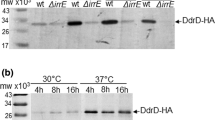Abstract.
RecA protein is essential for the very high level of resistance of Deinococcus radiodurans to DNA damage induced by ionizing radiation or other DNA-damaging agents. Since the mechanism(s) involved in the control of recA expression and the extent of RecA induction following DNA damage in this species are still unclear, we have performed a genetic analysis of the recA locus and quantified the basal and induced levels of RecA protein in wild type, recA, and lexA mutants. We found that the two genes upstream of recA in the predicted cinA ligT recA operon appear to have no role in the regulation of recA expression or function, despite the fact that the reading frames in the operon overlap. By using a translational fusion of recA to a lacZ reporter gene, we showed that induction began with no delay following exposure to γ-radiation or treatment with mitomycin, and continued at a constant rate until it reached a plateau. The induction efficiency increased linearly with inducer dose, levelling off at a concentration fourfold above the background. The basal concentration of RecA protein measured by Western blotting corresponded to approximately 11,000 monomers per cell, and the induced concentration to around 44,000 monomers per cell. These levels remained unchanged upon disruption of the lexA gene, indicating that LexA does not plays a role in recA regulation. However, inactivation of lexA caused cells to aggregate, suggesting that LexA may control the activity or expression of as yet undefined membrane functions. Cells bearing the recA670 mutation showed an elevated constitutive expression of recA in the absence of DNA damage. This phenotype did not result from the defect in DNA repair associated with the RecA670 protein, since the increased basal level of recA expression was also found in recA670/recA + diploid cells that are proficient in DNA repair. These results suggest that RecA may be involved in regulating its own expression, possibly by stimulating proteolytic modification of other regulatory proteins.
Similar content being viewed by others
Author information
Authors and Affiliations
Additional information
Electronic Publication
Rights and permissions
About this article
Cite this article
Bonacossa de Almeida, .C., Coste, .G., Sommer, .S. et al. Quantification of RecA protein in Deinococcus radiodurans reveals involvement of RecA, but not LexA, in its regulation. Mol Gen Genomics 268, 28–41 (2002). https://doi.org/10.1007/s00438-002-0718-x
Received:
Accepted:
Issue Date:
DOI: https://doi.org/10.1007/s00438-002-0718-x




